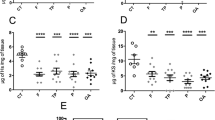Summary
Purified bovine nasal cartilage proteoglycans (aggregate and subunit containing fractions) and to a lesser degree, chondroitin 4-sulfate of physiological size, retard seeded hydroxyapatite (HA) growthin vitro. The large hydrodynamic size and high charge density of these macromolecules are believed to be associated with the ability of proteoglycans to inhibit HA formation and growth. We now demonstrate the involvement of the negative charges of proteoglycans in this inhibition (a) by comparing the inhibitory ability of chondroitin 4-sulfate and its desulfated analog, and (b) by comparing the growth of HA seed crystals coated either with proteoglycan aggregates or chondroitin 4-sulfate to that of uncoated crystals. In the desulfation experiments, desulfated chondroitin sulfate was a less efficient HA growth inhibitor than untreated, undesulfated chondroitin sulfate of similar molecular size. Dextran sulfate showed higher inhibitory effectiveness than unchanged neutral dextran. Both experiments suggest that sulfate groups play an important role in the regulation of mineral deposition by proteoglycans. In the coating experiment, precoating of HA seed crystals with proteoglycan aggregates decreased the amount of HA precipitated as a function of time, suggesting proteoglcans may block the active nucleating sites on HA surface and slow down the growth process. Chondroitin 4-sulfate has a similar but weaker coating effect. Neural dextran, having little affinity for HA, had no effect.
Similar content being viewed by others
References
Hulth A (1958) Retardation of the endochondral growth by papain. Acta Orthop Scand 28:1–21
Binderman I, Greeve R, Pennypacker J (1979) Calcification of differentiating skeletal mesenchyme in vitro. Science 206:222–225
Chen C-C, Boskey AL, Rosenberg LC (1984) The inhibitory effect of cartilage proteoglycans on hydroxyapatite growth. Calcif Tissue Int 36:285–290
Muir H (1980) The chemistry of the ground substance of joint cartilage. In: Sokoloff L (ed) The joints and synovial fluid. Vol. 2. Academic Press. New York, pp 27–94
Maroudas A (1979) Physiochemical properties of articular cartilage. In: Freeman M (ed) Adult articular cartilage. Pitman Medical Kent, England, pp 215–290
Kantor TG, Schubert M (1957) The difference in permeability of cartilage to cationic and anionic dyes. J Histochem Cytochem 5:28–32
Francis MD (1969) the inhibition of calcium hydroxypatite crystal growth by polyphosphonates and polyphosphates. Calcif Tissue Res 3:151–162
Blumenthal NC, Betts F, Posner AS (1977) Stabilization of amorphous calcium phosphate by Mg and ATP. Calcif Tissue Res 23:245–250
McGann TCA, Kearney RD, Buchheim W, Posner AS, Betts F, Blumenthal NC (1983) Amorphous calcium phosphate in casein micelles of bovine milk. Calcif Tissue Int 35:821–823
Nagasawa K, Inoue Y, Kamata T (1977) Solvolytic desulfation of glycosaminoglycuronan sulfates with dimethyl sulfoxide containing water or methanol. Carbohydrate Res 58:47–55
Nagasawa K, Inoue Y, Tokuyasu T (1979) An improved method for the preparation of chondroitin by solvolytic desulfation of chondroitin sulfates. J Biochem 86:1323–1329
Bitter T, Muir HM (1962) A modified uronic acid and carbazole reaction. Anal Biochem 4:330–334
Roe JH (1955) The determination of sugar in blood and spinal fluid with anthrone reagent. J Biol Chem 212:335–343
Dodgson KS, Price RG (1962) A note on the determination of the ester sulphate content of sulphated polysaccharides. Biochem J 84:106–110
Posner AS, Betts F, Blumenthal NC (1979) Bone mineral composition and structure. In: Simmons D, Kunin A (eds) Skeletal research. Academic Press, New York, pp 167–192
Maroudas A (1975) Biophysical chemistry of cartilaginous tissues with special reference to solute and fluid transport. Biocheology 12:233–248
Willis JB (1960) The determination of metals in blood serum by atomic absorption spectroscopy. Calcium Spectrochim Acta 16:259–272
Heinonen JK, Lahti RJ (1981) A new and convenient colorimetric determination of inorganic orthophosphate and its application to the assay of inorganic pyrophosphates. Anal Biochem 113:313–317
Muir H, Hardingham TE (1975) Structure of proteoglycans. In: Whelan WJ (ed) Biochemistry of carbohydrates. vol. 5 Butteworths/University Park Press, Baltimore, pp 153–221
Cuervo LA, Pita JC, Howell DS (1973) Inhibition of calcium phosphate mineral growth by proteoglycan aggregate fractions in a synthetic lymph. Calcif Tissue Res 13:1–10
Blumenthal NC (1981) Mechanism of proteoglycan inhibition of hydroxyapatite formation. In: Veis A (ed) The chemistry and biology of mineralized connective tissues. Elsevier North Holland, New York, pp 509–515
Wikstrom B, Gay R, Gay S, Hjerpe A, Mengarelli S. Reinholt FP, Engfeldt B, (in press) Morphological studies of the epiphyseal growth zone in the brachymorphic (bm/bm) mouse. Virchows Archiv
Orkin RW, Williams BR, Cranley RE, Poppke DC, Brown KS (1977) Defects in the cartilaginous growth plates of brachymorphic mice. J Cell Biol 73:287–299
Sugahar K, Schwartz NB (1979) Defect in 3′-phosphoaden osine 5′-phosphosulfate formation in brachymorphic mice Proc Natl Acad Sci USA 76:6615–6618
Orkin RW, Pratt RM, Martin GR (196) Undersulfated chondroitin sulfate in the cartilage matrix of brachymorphic mice. Dev Biol 50:82–94
Embeery G, Rølla G (1980) Interaction between sulfated macromolecules and hydroxyapatite studied by infrared spectroscopy. Acta Odentol Scan 38:105–108
Author information
Authors and Affiliations
Rights and permissions
About this article
Cite this article
Chen, CC., Boskey, A.L. Mechanisms of proteoglycan inhibition of hydroxyapatite growth. Calcif Tissue Int 37, 395–400 (1985). https://doi.org/10.1007/BF02553709
Issue Date:
DOI: https://doi.org/10.1007/BF02553709




